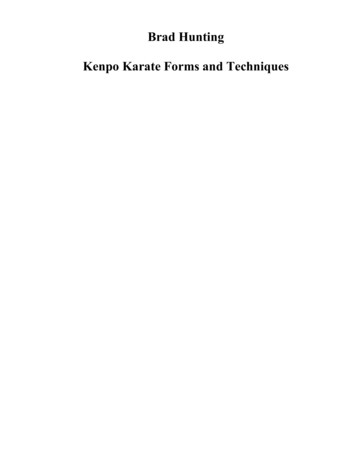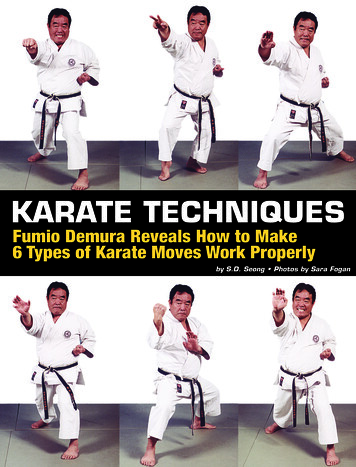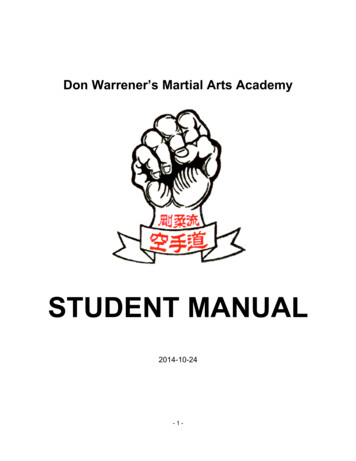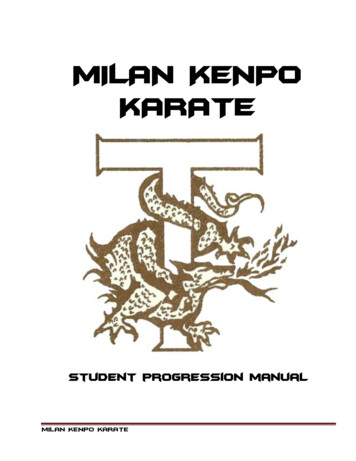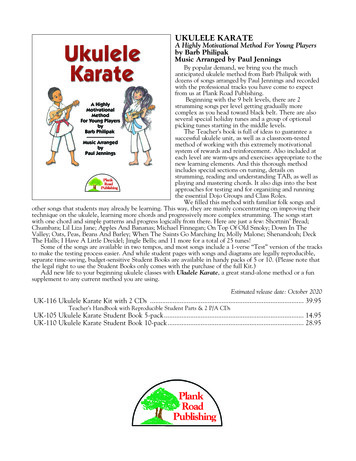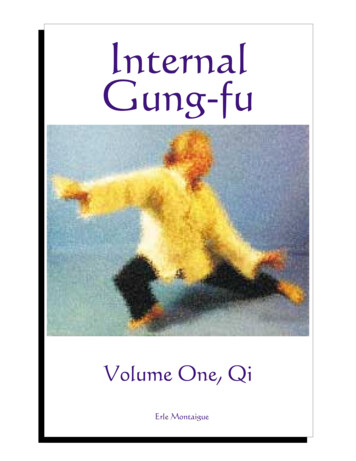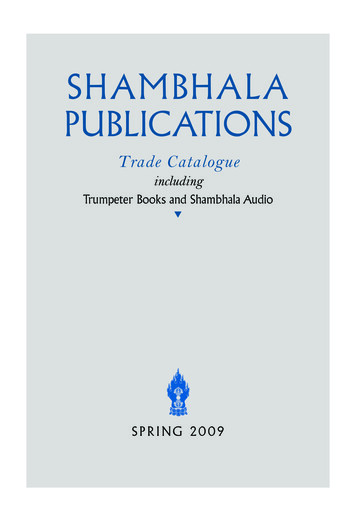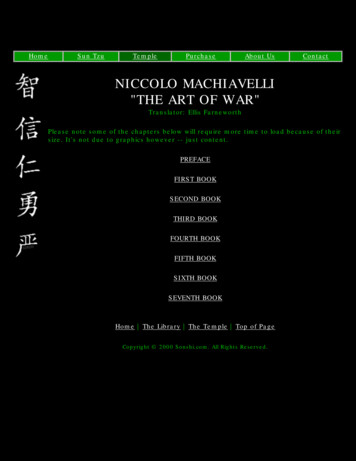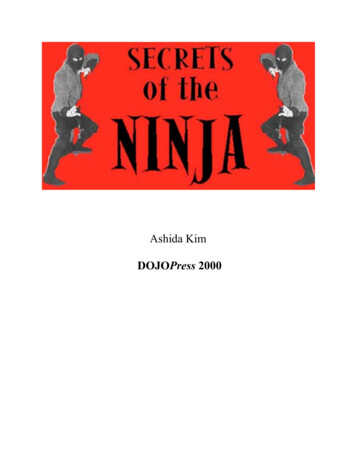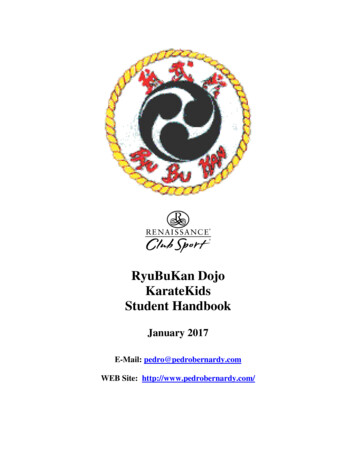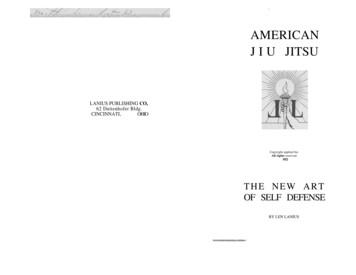
Transcription
Okinawan KarateDojo’sStudent ManualUpdated: 10/24/2017Property of the Okinawan Karate Dojo
TABLE OF CONTENTS1.2.3.4.5.6.7.IntroductionWhat is Karate?HistoryDojo Rules and EtiquetteStudent CreedBasic TerminologyCore Curriculuma. Junbi Undo (Warm-up and Stretching)b. Hojo Undo (Basic Techniques)c. Kata (Forms)d. Yakusoku Kumite (Pre-arrangedPartnership Drills)e. Bunkai (Partnered Kata Application)f. Jiyu Kumite (Sparring)g. Kote kitae (Body Conditioning)8. Rank Promotions9. Ranksa. Kyu Ranksb. Dan Ranksc. DragonsUpdated: 10/24/2017Property of the Okinawan Karate Dojo
IntroductionWelcome to a brief insight into the Okinawan Karate Dojo, our karateand our curriculum. Uechi-ryu karate-do is a traditional Okinawan style ofkarate, and is the type of martial arts that we study and practice in our dojo(way place). It was developed by Kanbun Uechi in the late 1800s/early1900′s, following Kanbun’s training for a number of years in China. Uechiryu (pronounced – “Ew-way-chee Roo”), literally translates to Uechi’s way,and is named after Kanbun Uechi.Karate means - empty or open (kara)/hand (te) and is an un-armedversion of self-defense and character preparation. As parent or student, allinvolved will WIN along the journey you have begun towards super herotraining! The study and practice of Uechi-ryu karate can be fun for peopleof all ages (3 and up). It involves/comes from three main areas of focus:Kata, Kumite, and Conditioning.Kata are the pre-arranged routines that students practice so they canbuild confidence in a developing skillset. Kumite is the word used for realtime application (or sparring). Whether practiced through safe, partnershipdrills, sparring matches (age-dependent), or during individual learning,kumite helps students understand how to apply their techniques in a varietyof changing situations, against one or more opponents. Conditioning thebody with improved cardio and muscular endurance, agility andcoordination, strength and flexibility, focus, confidence, poise and more karate training helps give birth to all sorts of productive habits in itsstudents. In addition to kata, kumite, and conditioning, students areengaged through other activities and exercises that all providecomprehensive exposure.Please enjoy your read through of this material. We can answer anyquestions or provide you more information, so please don't hesitate to sendus an email at: okinawnkaratedojo@gmail.com or see me or one of theOkinawan Karate Dojo (OKD) staff in the dojo.Sensei StanUpdated: 10/24/2017Property of the Okinawan Karate Dojo
A BRIEF HISTORY OF UECHI RYU KARATE DOAs outlined by Sensei Stanley CrumpUechi-Ryu and Kanbun Uechi1877 –Kanbun Uechi was born on May 5, 1877 in the Takinto mountain village of Okinawa.He was born into a family of farmers where he learned herbal medicine and how to usefarming tools as weapons.1897 – By the time he was 20 years old, Kanbun was 5’ 5’’ and very strong from tilling soil asa farmer. He avoided being drafted into the war by escaping to Fuchow City in the FukienProvince of China in March of 1897. There, he began his vigorous perfection of martial arts,specifically Chuan Fa.One man who made the greatest impact on Kanbun’s martial arts training was a mannamed, Chou Tsu Ho (pronounced in Japan as Shushiwa). In his school, The Fu Chuan ShinTemple, Shushiwa allowed Kanbun to train with him because Kanbun healed Shushiwa’smigranes with an herbal medicine mixture that he made. The first 3 years of Kanbun’straining with Shushiwa were focused only on Sanchin training and body conditioning (kotekitae).1904 - At the age of 27 years old, Kanbun received a Master Certificate of ChinesePangainoon (the half-hard half-soft style). He diligently taught Pangainoon from a preciseand traditional perspective for another 3 years with/under Shushiwa. He was taught 3 of the4 katas: Sanchin (3 conflicts), Seisan (13 conflicts), and Sanseiryu (36 conflicts). Kanbun leftChina before learning Suparimpe.1907 - By the age of 30, Kanbun opened his first dojo, the Pangainoon Kempo Sho, and hetaught there until 1910. His reputation as a remarkable martial artist became widespreadthrough parts of China and into Okinawa.1910 and 1911 – Kanbun Uechi returns to Okinawa and his son, Kanei Uechi, was born.1925 – Kanbun moved to Kansai, Japan and opened his first dojo, the Shataku Dojo, andbegan teaching Uechi-ryu under the name “Pangainoon”.1927 – Kanei Uechi moved to Japan to study under his father, Kanbun. Kanbun Uechibefriended Seiryo Shinjo who also joined the Shataku Dojo and remained a student of Kanbunfor 10 years1942 – Kanei Uechi moved back to Okinawa to begin teaching Uechi-ryu.1946 – Kanbun and his some of his senior students (including Seiryo Shinjo and SeikoToyama) returned to (Ie-jima Island) Okinawa.1948 – Kanbun Uechi died. Various branches of Uechi-ryu are formed as a result (undermany of his senior students). His son, Kanei, continued to teach in Naha City, Okinawa.Updated: 10/24/2017Property of the Okinawan Karate Dojo
Kenyukai and Kiyohide Shinjo.1929 - Seiryo Shinjo’s son , Seiyu Shinjo, was born in Japan.1939 – Seiyu Shinjo became a student of Kanbun at 10 years old.1946 – Seiyu Shinjo and his father returned to (Ie-jima Island) Okinawa.1948 – Kanbun Uechi died.1951 – Seiyu Shinjo’s first son was born Kiyohide Shinjo.1953 – Seiyu moved to Naha City in Okinawa and continued to train under Kanei Uechi.1960 – Seiyu Shinjo and his father moved to Kadena City, Okinawa and opened the KadenaShubukan Dojo. Seiyu Shinjo’s second son, Narahiro Shinjo, was born, and Kiyohide begaintraining.1968 - Kiyohide Shinjo was promoted to Shodan (first degree black belt).1970 – Kiyohide Shinjo won 1st place in both kata (forms) and kumite (sparring) in the 3rdannual All Okinawan Championship Tournament and continued to do so for a record nineyears straight earning him the title “Okinawa’s Superman”.1980 – Kiyhohide Shinjo was inducted to the Board of Directors of the All Okinawan KarateFederation. He was the Chairman of the Board from 1991 through 1994. He still serves onthis Board today.1981 – Seiyu Shinjo, Kiyohide’s father, died 52 years of age.1981 through 2004 – Narahiro Shinjo placed 1st in kata in 6 of the annual All OkinawanChampionship Tournaments. Kiyohide Shinjo founded a “fraternity” within the Uechi-ryuAssociation, to honor his father, called Kenyukai. Ken means “fist”. Yu is part of his father’sname, “Seiyu”. Kai means “group”. Together, the name Kenyukai stands for “Seiyu Shinjo’sStrong Fist Group”. The Okinawan Karate Dojo is part of the Uechi-ryu Kenyukai Karate-do,North America family.2004 - Kiyohide Shinjo remains the President of the Worldwide Uechi Ryu Association andopened his new dojo in Zakimi City, Okinawa.2016 – Sensei Stanley Crump officially became a student of Sensei Kiyohide Shinjo.Updated: 10/24/2017Property of the Okinawan Karate Dojo
Dojo RulesStudents must follow the basic class rules:1. Students must be respectful to the dojo. Studentsshould not use dojo equipment without permission,damage dojo property, or climb on heavy bags, mats,or chairs. Students must also avoid leaning on ortouching the mirrors.2. Students must be respectful to the instructors andothers. Students are not to disturb others in class, bea distraction in class, or hit other students in a nonsparring setting.3. Shoes are not permitted on the dojo floor.4. Students must bow before and after leaving the dojo.5. All parents and students must remain silent duringclasses so the sensei can instruct.6. Students must raise their hand and ask to leave thedojo floor (bathroom, water, etc.)7. Parents must be present at all Dragons classes8. Parents must pick up their children in a timelymanner.Updated: 10/24/2017Property of the Okinawan Karate Dojo
Student CreedI will develop myself in a positive manner andavoid anything that would reduce my mentalgrowth or physical health.I will develop self discipline in order to bringout the best in myself and others.I will use common sense before self-defenseand never be abusive or offensive.Updated: 10/24/2017Property of the Okinawan Karate Dojo
OneIchiSixRokuBasic TerminologyTwo ThreeFourNiSan Shi (Yon)Seven EightNineShichi HachiKyuKara – OpenTe – HandsDojo – Way PlaceKata – FormsKobudo – Weapons, or ancient artsKumite – Touching Hands, SparringSensei – TeacherSempai – Senior StudentKiotsuke – Find Your Focus (and attack)Rei – Respect (or to bow)Onegaishimasu – Please Teach MeDomo Arigato – Thank YouArigato Gozaimasu – Thank You (Formal)Karate-ka – One who practices KarateGi – Karate UniformObi – BeltMigi ashi – Right FootHidari ashi – Left FootKamae – Hand Position/Ready PositionDachi – Foot Position/StanceHiza - KneeUpdated: 10/24/2017FiveGoTenJuTsuki/zuki – Strike or PunchSeiken Tsuki – Whole Fist PunchHiraken Tsuki – Half Fist PunchShoken Tsuki – One-Knuckle PunchMawashi Tsuki – Round/Hook PunchHiji Tsuki – Elbow StrikeShuto – Chop/Knife-blade HandSokuto Geri – Knife-blade KickShomen/Mae Geri – Front KickMawashi Geri – Roundhouse KickYoko Geri – Side KickUke – Block/receiveMawashi Uke – Circle BlockWauke – Double Circle BlockGedan Barai – Low Sweep (Block)Jodan (Age) Uke – Rising High BlockSukui Uke – Scooping BlockHaito – Ridge-handUraken – Back-fistBoshiken – Thumb StrikeKoken – Crane StrikeProperty of the Okinawan Karate Dojo
Core CurriculumJunbi UndoWarm-up and Stretching1.2.3.4.5.6.7.8.9.10.Ashi saki o ageru – heel pivotKakato o ageru undo – heel liftAshikubi o mawasu undo – foot and ankle twistHiza o mawasu undo – knee circlesAshi o mae yoko shita ni nobasu undo - leg lift and turnAshi o mae uchi naname ni ageru undo – straight leg liftTai o mae ni taosu undo – waist scoopKoshi no nenten – trunk stretchUdo o mae yoko shita ni nobasu undo - double arm strikeKubi o mawasu undo – neck rotationHojo UndoBasic Techniques1.2.3.4.5.6.7.8.9.10.11.12.13.14.Sokuto geri – knife-edge kickShomen geri – front kickMawashi tsuki – roundhouse punchSeiken tsuki – whole-fist punchHajiki uke hiraken tsuki – half-fist snap-blocks and strikesShuto uchi ura uchi shoken tsuki – chop, back-fist, oneknuckle punchHiji tsuki - elbow strikeTenshin zensoku geri – side-step and front kick w/ front legTenshin kosoku geri – side-step and front kick w/ back legTenshin shoken tsuki – side-step and one-knuckle punchShomen hajiki – Front snap strikesKoi no shippo uchi, tate uchi – wrist blocks, four directionsKoi no shippo uchi, yoko uchi – wrist blocks, side-to-sideShin Kokyu – Deep breathingUpdated: 10/24/2017Property of the Okinawan Karate Dojo
KataFormsKatas are pre-arranged routines and techniquesthat are the foundation of karate. Repetition of thesekatas condition the body and mind to perform thetechniques exactly while improving a student’sunderstanding and readiness for an actual situation.We have 8 katas in our system:Sanchin KanshiwaKanshuSeichinSeisan SeiryuKanchinSanseirui The three original katas taught to Kanbun Uechi. All other katas were invented byKanbun’s son, Kanei Uechi, and other senior students.Updated: 10/24/2017Property of the Okinawan Karate Dojo
Yakusoku KumitePre-arranged Partnership DrillsKyu KumitePartnership exercise for Kyu ranks. Five partnered(offensive and defensive) exchanges total. Bothpartners demonstrate each exchange before moving onto the next one.Kenyukai Dan KumitePartnership exercise for sankyu through all Dan ranks.Seven partnered (offensive and defensive) exchangestotal. Each partner demonstrates all seven offensive ordefensive exchanges, and then the partners switchroles. This exchange is specific to Uechi-ryu KenyukaiKarate-do.Uechi-Ryu Dan KumiteThe original Dan Kumite practiced in all Uechi-ryustyles.Updated: 10/24/2017Property of the Okinawan Karate Dojo
BunkaiPartnered Kata applicationBunkai is the application of a kata. Basically, bunkai isa partnered exercise where one partner attacks theother while the other partner uses techniques in thekata. This is to demonstrate one’s understanding ofthe techniques in the kata and how to utilize them inan actual scenario.The exchange is a formal demonstration of both thekata and the application of the moves in the kata.Kanshiwa bunkai is the most commonly taught bunkaiin our system because of its simplicity. It is typicallynot required for Kyu ranks, but Seisan bunkai isrequired on all Dan tests.Typically, bunkai is not fully explored until onereceives the Dan/ Jr. Dan.Updated: 10/24/2017Property of the Okinawan Karate Dojo
Jiyu KumiteSparringKumite is the real-time exchange of techniques. This isthe most effective way to test one’s understanding ofkarate. Controlled matches prepare students to facethe rough challenges of self defense. Sparring caneither be done free-style or by points.Free-style sparring is typically just a continuous match(lasting up to 3 minutes, typically 1 to 2 minutes). Thisis more oriented to real-life application because there isno stopping between exchanges or if someone is hit,unless called by the center judge.Point sparring is where various techniques are worthcertain points and the goal is to earn more points thanyour opponent. This style is more sport-oriented andfollows a strict set of rules. It is not continuous becauseafter an exchange where a combatant is hit, there is abreak in the match so that points can be awarded. Ourrules for point sparring is a slightly modified version ofthe World Karate Federation (WKF) rules.Updated: 10/24/2017Property of the Okinawan Karate Dojo
Kote kitaeBody ConditioningBody conditioning is an important aspect of karate.As students get older and/or at higher ranks, theyparticipate in what is called kote kitae, which literallymeans “arm-pounding.” We use it as a general term forall body conditioning exercises. The basic exercisesinclude:1) Arm Rubbing2) Arm Pounding3) Upper Leg Kicks4) Lower Leg KicksAlthough this is the standard exercise done, there aremany ways one can condition their body. Regularstrength training, cardio, various leg kicks, bodystrikes, or different arm pounding exercises can all beused to help strengthen one’s body.Updated: 10/24/2017Property of the Okinawan Karate Dojo
RanksRanks are divided into two 2 major groups: Kyu andDan. Kyu ranks are those who are not yet black belts (Danranks). These include students from white all the way toBrown/Jr. Black. Kyu ranks typically follow a 10-stepranking system (for those over 6 years of age) that leads toearning one’s black belt.Dan ranks are those who have earned their black belts.After achieving all 10 Kyu ranks, one is eligible to test fortheir black belt. There are 10 Dan ranks, where tests aremore challenging as you move up, and may take severalyears between rank promotions. It typically takesapproximately 4-5 years for one to earn their first Dan rank,and you must be at least 15 years old.Updated: 10/24/2017Property of the Okinawan Karate Dojo
Rank PromotionsRank promotions are a test of a students growth in the dojo. Their karateis put to the test in front of a test board of higher ranking Dan students andthe Sensei. Although students typically advance from one belt to the next,there is no guarantee you will earn your next rank when you test. This meansit is possible to not pass a test if you do not meet the guidelines to pass.However, we do not ask students to test unless we know that they are readyfor the next level.Typically, a student is eligible to test if they have regularly attendedclasses (minimum of 20 classes), and it has been at least 3 months since theirlast belt test. Although students may meet these requirements, it is entirelyup to the discretion of the Sensei to invite you to test. After brown belt, thecost for belt tests increases due to testing periods that occur less frequently.Black belt tests are, by far, the most rigorous and demanding tests.This test has very strict guidelines and a scoring system where each sectionearns you points depending on how well you perform. Black belt tests aredone in front of a committee of senior black belts and the sensei.As Students move up to more advanced ranks, their expected level ofproficiency during a test will need to reflect the more formal/traditionalrequirements for these ranks. As a result, to earn your green belt(Gokyu) and beyond, students will be scored (during their tests)on a test sheet, provided by Grand Master Kiyohide Shinjo. Eachagenda item of the test as a certain range and students are required toexceed a certain minimum score in each segment. This allows the test boardto more accurately assess test candidates of higher ranking belts.Updated: 10/24/2017Property of the Okinawan Karate Dojo
Kyu Ranks*Jukyu – White BeltKyukyu – Yellow BeltHachikyu – Purple BeltShichikyu – Blue Belt*Rokkyu – Red Belt*Gokyu – Green BeltYonkyu – Green Belt w/ 1 StripeSankyu – Brown BeltNikyu – Brown Belt w/ 1 StripeIkkyu – Brown Belt w/ 2 StripeIkkyu – Jr. Black Belt***At these critical ranks, additional stripes can be added to student’srank upon promotion by the Sensei’s discretion**Jr. Black belts are awarded to those whose would be eligible to testfor their Dan rank, but do not meet the age requirement (15 years old).Updated: 10/24/2017Property of the Okinawan Karate Dojo
LevelBeginnerAge RequirementNoneRequirementsAn eagerness to learnA positive attitudeWorking on Hojo Undo (1-4) Sanchino Elements of Sanchin: the opening, steppingand striking, turning, waukes Kanshiwa (front)o Elements of Kanshiwa: turn-block-punch,step-block-kick, horse-stance Punching Drillo Basic partnered blocks/punches: steppingback with low, middle, and high blocks, andstepping forward with low, middle, and highpunchesUpdated: 10/24/2017Property of the Okinawan Karate Dojo
LevelBeginnerAge Requirement6 years oldClass Requirements Minimum 12 weeks from previous rankpromotion Minimum 20 classes attended NOTE: Eligibility to test up to the discretion ofthe SenseiMaterial Covered on Test Hojo Undo 1 – 4 (Sensei Assisted)SanchinKanshiwa (Front/Segments)Punching DrillUpdated: 10/24/2017Property of the Okinawan Karate Dojo
LevelBeginnerAge Requirement6 years oldClass Requirements Minimum 12 weeks from previous rankpromotion Minimum 20 classes attended NOTE: Eligibility to test up to the discretion ofthe SenseiMaterial Covered on Test Hojo Undo 1 – 7SanchinKanshiwa (Front)Punching DrillSparringUpdated: 10/24/2017Property of the Okinawan Karate Dojo
LevelBeginner/IntermediateAge Requirement6 years oldClass Requirements Minimum 12 weeks from previous rankpromotion Minimum 20 classes attended NOTE: Eligibility to test up to the discretion ofthe SenseiMaterial Covered on Test Hojo UndoSanchinKanshiwaKyu Kumite 1 – 3Kote kitae (Cranes, and Adults)SparringUpdated: 10/24/2017Property of the Okinawan Karate Dojo
LevelIntermediateAge Requirement8 years oldClass Requirements Minimum 12 weeks from previous rankpromotion Minimum 20 classes attended NOTE: Eligibility to test up to the discretion ofthe SenseiMaterial Covered on Test Hojo UndoSanchinKanshiwaKanshu (Front)Kyu Kumite 1 – 3Kote kitae (Samurai, Cranes, and Adults)SparringUpdated: 10/24/2017Property of the Okinawan Karate Dojo
LevelIntermediateAge Requirement8 years oldClass Requirements Minimum 12 weeks from previous rankpromotion Minimum 20 classes attended NOTE: Eligibility to test up to the discretion ofthe SenseiMaterial Covered on Test Hojo UndoSanchinKanshuKyu KumiteKote kitae (Samurai, Cranes, and Adults)SparringUpdated: 10/24/2017Property of the Okinawan Karate Dojo
LevelIntermediateAge Requirement8 years oldClass Requirements Minimum 24 weeks from previous rankpromotion Minimum 40 classes attended NOTE: Eligibility to test up to the discretion ofthe SenseiMaterial Covered on Test Hojo UndoSanchinKanshuKyu KumiteKote kitae (Samurai, Cranes, and Adults)SparringUpdated: 10/24/2017Property of the Okinawan Karate Dojo
LevelAdvancedAge Requirement10 years oldClass Requirements Minimum 16 weeks from previous rankpromotion Minimum 25 classes attended NOTE: Eligibility to test up to the discretion ofthe SenseiMaterial Covered on Test Hojo UndoSanchinSeichinKyu KumiteDan Kumite 1-3Kote kitaeKoto Shimon (Verbal Exam)SparringUpdated: 10/24/2017Property of the Okinawan Karate Dojo
LevelAdvancedAge Requirement10 years oldClass Requirements Minimum 16 weeks from previous rankpromotion Minimum 25 classes attended NOTE: Eligibility to test up to the discretion ofthe SenseiMaterial Covered on Test Hojo UndoSanchinSeichinKyu KumiteDan Kumite 1-5Kote kitaeKoto ShimonSparringUpdated: 10/24/2017Property of the Okinawan Karate Dojo
LevelAdvancedAge Requirement10 years oldClass Requirements Minimum 16 weeks from previous rankpromotion Minimum 25 classes attended NOTE: Eligibility to test up to the discretion ofthe SenseiMaterial Covered on Test Hojo UndoSanchinSeichinDan KumiteKote kitaeKoto ShimonSparringUpdated: 10/24/2017Property of the Okinawan Karate Dojo
LevelAdvancedAge Requirement12 years oldClass Requirements Minimum 24 weeks from previous rankpromotion Minimum 40 classes attended NOTE: Eligibility to test up to the discretion ofthe SenseiMaterial Covered on Test Hojo UndoSanchinSeisanKanshiwa BunkaiDan KumiteKote kitaeKoto ShimonSparringUpdated: 10/24/2017Property of the Okinawan Karate Dojo
Dan RanksShodan – 1st Degree Black BeltNidan – 2nd Degree Black BeltSandan – 3rd Degree Black BeltYondan – 4th Degree Black BeltGodan – 5th Degree Black BeltRokudan – 6th Degree Black beltNanadan – 7th Degree Black BeltHachidan – 8th Degree Black BeltKyudan – 9th Degree Black BeltJudan – 10th Degree Black BeltUpdated: 10/24/2017Property of the Okinawan Karate Dojo
LevelDanAge Requirement15 years oldClass Requirements Minimum 24 Weeks as Ikkyu Minimum 40 classes attended NOTE: Eligibility to test up to the discretion ofthe SenseiMaterial Covered on Test Hojo UndoSanchinSeisanSeisan BunkaiDan KumiteKote kitaeKoto ShimonSparringUpdated: 10/24/2017Property of the Okinawan Karate Dojo
DragonsThe Dragons curriculum focuses on kids from ages3 to 6. The curriculum is much different than ourstandard curriculum so that the students can get themost out of their karate without it being toochallenging. The Dragons focus on basics, such as thebasic punches, blocks, and kicks, simple agilityexercises and movements, and even partnered drills.We primarily not only just teach karate, but weteach students how to be more focused, respectful, andpatient. This will not only help them as they graduateto the Tigers program, but it will also help them outsideof the Dojo, as they move to kindergarten or the firstgrade.Rank promotions are based on proper techniqueand focus, but promotions can also be determined byage.Updated: 10/24/2017Property of the Okinawan Karate Dojo
LevelBeginnerAge Requirement3 years oldClass Requirements Minimum 10-12 weeks from previous rankpromotion Minimum 20 classes attended NOTE: Eligibility to test up to the discretion ofthe SenseiMaterial Covered on Test Basic Punches, Blocks, and KicksSanchin openingStep-Punch/Step-blockPartnered punching/blockingBasic display of respect and self-controlUpdated: 10/24/2017Property of the Okinawan Karate Dojo
LevelBeginnerAge Requirement4 years oldClass Requirements Minimum 10-12 weeks from previous rankpromotion Minimum 20 classes attended NOTE: Eligibility to test up to the discretion ofthe SenseiMaterial Covered on Test Basic punches, blocks, and kicksSanchin (opening, strikes, steps)Step-punch/step-block/step-kickPartnered block and counterPunching drill/elementsBasic display of respect and self-controlUpdated: 10/24/2017Property of the Okinawan Karate Dojo
LevelBeginnerAge Requirement5 years oldRequirements Minimum 10-12 weeks from previous rankpromotion Minimum 20 classes attended NOTE: Eligibility to test up to the discretion ofthe SenseiMaterial Covered on Test Basic punches, blocks, and kicksSanchin (opening, strikes, steps, turns, pingPunching drillBasic display of respect and self-controlUpdated: 10/24/2017Property of the Okinawan Karate Dojo
karate, and is the type of martial arts that we study and practice in our dojo (way place). It was developed by Kanbun Uechi in the late 1800s/early 1900′s, following Kanbun’s training for a number of years in China. Uechi-ryu (pronounced – “Ew-way-chee Roo”), literally tr
